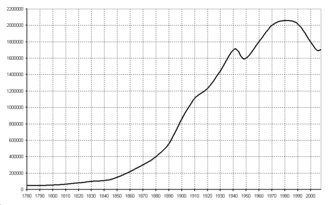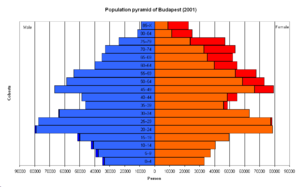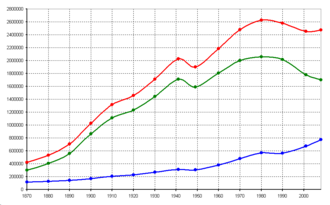
Demographics of Budapest
Encyclopedia

Budapest
Budapest is the capital of Hungary. As the largest city of Hungary, it is the country's principal political, cultural, commercial, industrial, and transportation centre. In 2011, Budapest had 1,733,685 inhabitants, down from its 1989 peak of 2,113,645 due to suburbanization. The Budapest Commuter...
Capital, Hungary
Hungary
Hungary , officially the Republic of Hungary , is a landlocked country in Central Europe. It is situated in the Carpathian Basin and is bordered by Slovakia to the north, Ukraine and Romania to the east, Serbia and Croatia to the south, Slovenia to the southwest and Austria to the west. The...
. In 2011 the official Budapest metropolitan area
Budapest metropolitan area
The Budapest Metropolitan Area is a metropolitan area in Central Hungary. It consists of Budapest capital and the surrounding suburbs. It has a population of 2.525 million...
has 2,551,247 inhabitants and in the official Budapest commuter area (established by the government in 2005) lived 3,271,110 people (2009), so the Hungarian metropolis is the largest metropolitan area
Metropolitan area
The term metropolitan area refers to a region consisting of a densely populated urban core and its less-populated surrounding territories, sharing industry, infrastructure, and housing. A metropolitan area usually encompasses multiple jurisdictions and municipalities: neighborhoods, townships,...
in Central-East Europe and the primate city
Primate city
A primate city is the leading city in its country or region, disproportionately larger than any others in the urban hierarchy. A 'primate city distribution' has one very large city with many much smaller cities and towns, and no intermediate-sized urban centres, in contrast to the linear 'rank-size...
of the Pannonian Basin
Pannonian Basin
The Pannonian Basin or Carpathian Basin is a large basin in East-Central Europe.The geomorphological term Pannonian Plain is more widely used for roughly the same region though with a somewhat different sense - meaning only the lowlands, the plain that remained when the Pliocene Pannonian Sea dried...
(former Greater Hungary
Kingdom of Hungary
The Kingdom of Hungary comprised present-day Hungary, Slovakia and Croatia , Transylvania , Carpatho Ruthenia , Vojvodina , Burgenland , and other smaller territories surrounding present-day Hungary's borders...
).
Nationalities



| Nationalities | Size | Note |
|---|---|---|
| Magyars | 1,631,043 (91.2%) | - |
| Germans Germans The Germans are a Germanic ethnic group native to Central Europe. The English term Germans has referred to the German-speaking population of the Holy Roman Empire since the Late Middle Ages.... |
18,097 (1%) | Danube Swabians Danube Swabians The Danube Swabians is a collective term for the German-speaking population who lived in the former Kingdom of Hungary, especially alongside the Danube River valley. Because of different developments within the territory settled, the Danube Swabians cannot be seen as a unified people... |
| Roma | 14,019 (0.8%) | Generality of them are Hungarian Hungarian language Hungarian is a Uralic language, part of the Ugric group. With some 14 million speakers, it is one of the most widely spoken non-Indo-European languages in Europe.... speaking Romungro |
| Slovaks Slovaks The Slovaks, Slovak people, or Slovakians are a West Slavic people that primarily inhabit Slovakia and speak the Slovak language, which is closely related to the Czech language.Most Slovaks today live within the borders of the independent Slovakia... |
4,929 (0.3%) | - |
| Greeks Greeks The Greeks, also known as the Hellenes , are a nation and ethnic group native to Greece, Cyprus and neighboring regions. They also form a significant diaspora, with Greek communities established around the world.... |
3,410 | - |
| Romanians Romanians The Romanians are an ethnic group native to Romania, who speak Romanian; they are the majority inhabitants of Romania.... |
2,637 | - |
| Chinese Han Chinese Han Chinese are an ethnic group native to China and are the largest single ethnic group in the world.Han Chinese constitute about 92% of the population of the People's Republic of China , 98% of the population of the Republic of China , 78% of the population of Singapore, and about 20% of the... |
2,289 | - |
| Ukrainians Ukrainians Ukrainians are an East Slavic ethnic group native to Ukraine, which is the sixth-largest nation in Europe. The Constitution of Ukraine applies the term 'Ukrainians' to all its citizens... |
2,055 | - |
| Poles Poles thumb|right|180px|The state flag of [[Poland]] as used by Polish government and diplomatic authoritiesThe Polish people, or Poles , are a nation indigenous to Poland. They are united by the Polish language, which belongs to the historical Lechitic subgroup of West Slavic languages of Central Europe... |
2,044 | - |
| Others | 4,327 | - |
| No answer, unknown | 93,071 | - |
Population by spoken language
| Language | Size | Note |
|---|---|---|
| Hungarian Hungarian language Hungarian is a Uralic language, part of the Ugric group. With some 14 million speakers, it is one of the most widely spoken non-Indo-European languages in Europe.... |
1,766,733 (99.4%) | Mother tongue |
| English English language English is a West Germanic language that arose in the Anglo-Saxon kingdoms of England and spread into what was to become south-east Scotland under the influence of the Anglian medieval kingdom of Northumbria... |
393,642 (22.1%) | Foreign language |
| German German language German is a West Germanic language, related to and classified alongside English and Dutch. With an estimated 90 – 98 million native speakers, German is one of the world's major languages and is the most widely-spoken first language in the European Union.... |
286,351 (16.1%) | Foreign and minority language |
| Russian Russian language Russian is a Slavic language used primarily in Russia, Belarus, Uzbekistan, Kazakhstan, Tajikistan and Kyrgyzstan. It is an unofficial but widely spoken language in Ukraine, Moldova, Latvia, Turkmenistan and Estonia and, to a lesser extent, the other countries that were once constituent republics... |
68,960 (3.9%) | Foreign language |
| French French language French is a Romance language spoken as a first language in France, the Romandy region in Switzerland, Wallonia and Brussels in Belgium, Monaco, the regions of Quebec and Acadia in Canada, and by various communities elsewhere. Second-language speakers of French are distributed throughout many parts... |
57,648 (3.2%) | Foreign language |
Religions
| Denomination | Size | Note |
|---|---|---|
| Roman Catholic | 808,460 (45.5%) | Mainly Magyar and German descendants |
| Calvinist | 224,169 (12.6%) | Only Magyar descendants |
| Lutheran | 46,449 (2.6%) | Magyar, German and Slovak descendants |
| Greek Catholic | 28,901 (1.6%) | Magyar descendants |
| Jewish Judaism Judaism ) is the "religion, philosophy, and way of life" of the Jewish people... |
9,468 (0.5%) | Generality of them are Magyarized Magyarization Magyarization is a kind of assimilation or acculturation, a process by which non-Magyar elements came to adopt Magyar culture and language due to social pressure .Defiance or appeals to the Nationalities Law, met... Neolog Jews |
| Other Christian Christian A Christian is a person who adheres to Christianity, an Abrahamic, monotheistic religion based on the life and teachings of Jesus of Nazareth as recorded in the Canonical gospels and the letters of the New Testament... |
20,523 | - |
| Others | 5,971 | - |
| Atheist | 374,209 (21%) | - |
| No answer, unknown | 286,584 | - |
Population by spoken language (1715-2001)
| Language | 1715 | 1737 | 1750 | 1851 | 1880 | 1890 | 1900 | 1910 | 1920 | 1930 | 1941 | 2001 |
|---|---|---|---|---|---|---|---|---|---|---|---|---|
| Hungarian Hungarian language Hungarian is a Uralic language, part of the Ugric group. With some 14 million speakers, it is one of the most widely spoken non-Indo-European languages in Europe.... |
19,4% | 22,5% | 22,2% | 36,6% | 56,7% | 67,1% | 79,6% | 85,9% | 90,2% | 94,3% | 97% | 99.4% |
| German German language German is a West Germanic language, related to and classified alongside English and Dutch. With an estimated 90 – 98 million native speakers, German is one of the world's major languages and is the most widely-spoken first language in the European Union.... |
55,6% | 57,8% | 55,2% | 56,4% | 34,3% | 23,7% | 14% | 9% | 6,5% | 3,8% | 1,9% | - |
| Slovak Slovak language Slovak , is an Indo-European language that belongs to the West Slavic languages .Slovak is the official language of Slovakia, where it is spoken by 5 million people... |
2,2% | 5,6% | 6,5% | 5% | 6,1% | 5,6% | 3,4% | 2,3% | 1,5% | 0,7% | 0,3% | - |
| Other | 22,8% | 14,1% | 16,1% | 2% | 2,9% | 3,6% | 3% | 2,8% | 1,8% | 1,2% | 0,8% | 0.6% |
Factory workers by nationality in Budapest (1877)
| Nationality | Share |
|---|---|
| Magyars | 46.6% |
| Foreigners | 25% |
| Slovaks Slovaks The Slovaks, Slovak people, or Slovakians are a West Slavic people that primarily inhabit Slovakia and speak the Slovak language, which is closely related to the Czech language.Most Slovaks today live within the borders of the independent Slovakia... |
22.2% |
| Serbs Serbs The Serbs are a South Slavic ethnic group of the Balkans and southern Central Europe. Serbs are located mainly in Serbia, Montenegro and Bosnia and Herzegovina, and form a sizable minority in Croatia, the Republic of Macedonia and Slovenia. Likewise, Serbs are an officially recognized minority in... |
0.9% |
| Romanians Romanians The Romanians are an ethnic group native to Romania, who speak Romanian; they are the majority inhabitants of Romania.... |
0.3% |
| Others | 5% |
Population by denominations (1870-1949)
| Denomination | 1870 | 1880 | 1890 | 1900 | 1910 | 1920 | 1930 | 1941 | 1949 |
|---|---|---|---|---|---|---|---|---|---|
| Roman Catholic | 72,3% | 67,4% | 64,7% | 60,7% | 59,8% | 59,1% | 60,7% | 63,7% | 71,3% |
| Calvinist | 4,8% | 6,1% | 7,4% | 8,9% | 9,9% | 10,9% | 12,1% | 13,6% | 15,5% |
| Lutheran | 5,3% | 5,5% | 5,6% | 5,3% | 5% | 4,8% | 5% | 5,3% | 5,4% |
| Jewish | 16,6% | 19,7% | 21% | 23,6% | 23,1% | 23,2% | 20,3% | 15,8% | 6,4% |
| Others | 1% | 1,3% | 1,3% | 1,5% | 2,2% | 2% | 1,9% | 1,6% | 1,4% |
Buda and Pest
| Year | Buda Buda For detailed information see: History of Buda CastleBuda is the western part of the Hungarian capital Budapest on the west bank of the Danube. The name Buda takes its name from the name of Bleda the Hun ruler, whose name is also Buda in Hungarian.Buda comprises about one-third of Budapest's... |
Pest Pest (city) Pest is the eastern, mostly flat part of Budapest, Hungary, comprising about two thirds of the city's territory. It is divided from Buda, the other part of Budapest, by the Danube River. Among its most notable parts are the Inner City, including the Hungarian Parliament, Heroes' Square and... |
Budapest Budapest Budapest is the capital of Hungary. As the largest city of Hungary, it is the country's principal political, cultural, commercial, industrial, and transportation centre. In 2011, Budapest had 1,733,685 inhabitants, down from its 1989 peak of 2,113,645 due to suburbanization. The Budapest Commuter... |
|---|---|---|---|
| 1720 | 9 600 | 2 600 | 12 200 |
| 1787 | 24 873 | 22 417 | 47 290 |
| 1799 | 24 306 | 29 870 | 54 176 |
| 1813 | 34 066 | 36 153 | 70 219 |
| 1848 | 40 500 | 110 516 | 151 016 |
| 1851 | 50 127 | 127 935 | 178 062 |
| 1869 | 70 000 | 200 476 | 280 349 |
| 1873 | 69 573 | 227 294 | 296 867 |
Budapest Capital
| > | Year | Population |
|---|---|
| 1870 | 302,085 |
| 1880 | 402,706 |
| 1890 | 560,079 |
| 1900 | 861,434 |
| 1910 | 1,110,453 |
| 1920 | 1,232,026 |
| 1930 | 1,442,869 |
| 1941 | 1,712,791 |
Budapest metropolitan area
| > | Year | Population |
|---|---|
| 1870 | 418,490 |
| 1880 | 530,556 |
| 1890 | 703,004 |
| 1900 | 1,027,626 |
| 1910 | 1,315,183 |
| 1920 | 1,459,449 |
| 1930 | 1,712,596 |
| 1941 | 2,025,402 |
Budapest suburban area
| > | Year | Population |
|---|---|
| 1870 | 116,404 |
| 1880 | 127,850 |
| 1890 | 142,925 |
| 1900 | 166,192 |
| 1910 | 204,730 |
| 1920 | 227,423 |
| 1930 | 269,727 |
| 1941 | 312,611 |
See also
- Demographics of HungaryDemographics of HungaryThis article is about the demographic features of the population of Hungary, including population density, ethnicity, education level, health of the populace, economic status, religious affiliations and other aspects of the population.-Historical:...
- BudapestBudapestBudapest is the capital of Hungary. As the largest city of Hungary, it is the country's principal political, cultural, commercial, industrial, and transportation centre. In 2011, Budapest had 1,733,685 inhabitants, down from its 1989 peak of 2,113,645 due to suburbanization. The Budapest Commuter...
- Greater BudapestGreater BudapestGreater Budapest is the name of Budapest in its present, extended size, as it was created by the Law No. XXVI of 1949 passed on December 15, 1949 and it came into force on January 1, 1950...
- Budapest metropolitan areaBudapest metropolitan areaThe Budapest Metropolitan Area is a metropolitan area in Central Hungary. It consists of Budapest capital and the surrounding suburbs. It has a population of 2.525 million...
- MagyarizationMagyarizationMagyarization is a kind of assimilation or acculturation, a process by which non-Magyar elements came to adopt Magyar culture and language due to social pressure .Defiance or appeals to the Nationalities Law, met...
- Neolog Judaism
- JudapestJudapestJudapest is an Antisemitic nickname for Budapest, the capital of Hungary. It derived from German word Juden, meaning Jews . Its connotations are similar to New York City's antisemitic nickname Jew York City.-History:...

